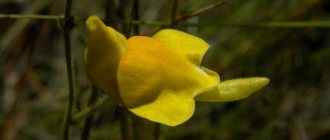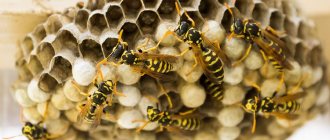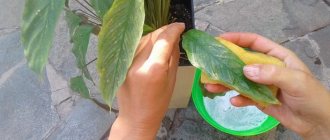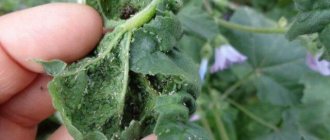Even the most soulful warm evening at the dacha can be ruined by annoying mosquitoes - constant companions of summer country life. The chemical industry has come up with hundreds of mosquito repellent drugs. To one degree or another, they are all effective, but have significant drawbacks - they are toxic to varying degrees, cause allergies, and in most cases are contraindicated for small children.
Lavender will drive mosquitoes away from the area. © bonnieheathestate
However, nature itself, having created mosquitoes (they are an important part of the food chain), made sure that they did not interfere with our lives. To do this, she has many plants in her arsenal that repel insects with their smell. In this publication we will talk about the 15 most effective plants - “mosquito repellents”, which can be successfully grown even in the middle zone.
Ageratum
Ageratum.
© Mauro Nogueira Many commercial mosquito repellents use coumarin, a substance secreted by the annual plant Ageratum. Delicate small ornamental bushes will decorate your flower beds (today varieties have already been bred not only with blue, but also with pink, white and lilac flowers) and will become reliable protection against annoying insects. However, you should not rub your skin with ageratum leaves and flowers. This may cause allergies. It is enough to simply plant a flower (or better yet, more than one) in the sun or partial shade. Ageratum is not a picky plant; it is content with poor soils.
Bush plants
Black elderberry
This shrub looks very elegant in the spring during flowering. But it is even more beautiful in the fall, when the clusters of berries turn black against the background of crimson-red foliage.
A beautiful hedge that easily takes the required shape. Repels all harmful insects, including mosquitoes. When planting, pay attention to the wind rose so that the scent from the elderberry spreads in the right direction.
On a note! Black elderberry berries are not only edible, but also very healthy. They treat joints, liver, drink for colds and varicose veins. You can make jellies, jams and preserves from the berries, add wine and tinctures. A wonderful jam that tastes like honey is made from black elderberry flowers.
Flower jam or a decoction of flowers is drunk for coughs, cystitis and other urological diseases. In baths, it rejuvenates the skin and gives vitality.
The only negative is that it does not tolerate drought, but is otherwise an unpretentious shrub.
Castor bean
The seeds of this plant are very poisonous, containing a strong protein poison, and after separating the poisonous cake, castor oil is obtained.
A large, powerful plant, similar to a palm tree, with carved leaves and bright flowers. Castor beans will help to reliably hide a fence or outbuildings from view. Wasps, flies, midges and mosquitoes cannot stand it.
Bird cherry
It has completely unique phytoncidal properties. In spring, its flowers will fill the entire area with fragrance. And in the fall, medicinal berries ripen, which are especially valued as a filling for pies.
Bird cherry was considered the best remedy for diarrhea, but the range of its medicinal properties is incredibly wide:
- It removes toxins and excess fluid.
- Strengthens the body's protective properties.
- Normalizes digestion.
- Reduces cholesterol levels.
- Helps with colds, fever, toothache.
Important!
But this is not all the possibilities of bird cherry. When consumed regularly, bird cherry helps restore male potency. Juice from the berries strengthens the nervous system, and externally helps to cope with acne. To get rid of wrinkles and dry skin, you need to use an infusion of bird cherry flowers.
Such a tree should be planted at the edge of the site to prevent harmful creatures from flying in.
Lavender angustifolia
Lavender.
© Marc Novakowski A very beautiful perennial plant with needle-like leaves and delicate white, pink, blue or purple flowers. Lavender angustifolia winters well in the middle zone, is unpretentious in care, grows in poor soils and does not require watering. Lavender bushes are ideal for group plantings and can also be grown in containers. A person can feel the pleasant smell of this plant only by touching it or cutting off its branches. But mosquitoes are more sensitive to its scent and find it disgusting. It has been noticed that mosquitoes do not fly in the immediate vicinity of lavender plantings (one to one and a half meters).
Mint
Mint is an extremely unpretentious plant that “spreads” across the site so quickly that at some point it can become a threat to other plantings. That is why mint is grown in open ground in places where other crops do not take root.
Alternatively, you can plant it in a tub or pot. Firstly, this way the mint will not grow too much, and secondly, you can quickly move it around the area.
To prepare a natural mosquito repellent spray, pour 200 g of fresh mint into 200 g of boiling water and let it brew for several hours. Strain the resulting infusion, and then pour 100 g of alcohol into it. The finished repellent is poured into a spray bottle and used as needed. It is best to store the prepared product in the refrigerator.
- 14 reasons to plant mint in your garden
Plant mint in your garden, and you will not only get fragrant leaves for tea, but also a lot of benefits from this plant.
Peppermint
Peppermint.
© Neil Goldstein The well-known peppermint - a fragrant perennial up to 80 cm high - is one of the most popular medicinal plants grown in our gardens. It is also widely used in cooking and cosmetology. Since ancient times, our ancestors have planted peppermint near windows and entrance doors to the house, in particular, because this plant repels mosquitoes well. The strongest menthol aroma comes from peppermint, growing in loose, fertile soils in sunny corners of the garden. But it can also grow in the shade, although the smell and, accordingly, repelling mosquitoes will be weaker.
What plants repel mosquitoes and midges?
Lavender
This plant has a strong and pleasant aroma that calms you after a long day and repels mosquitoes.
Mosquitoes are known to dislike the smell of lavender, and some claim that the smell interferes with the mosquitoes' sense of smell
.
This is a very tolerant plant that can tolerate drought, requiring only sun and good drainage.
You can crush the plant and mix it with any oil (such as almond) and rub it on your skin to repel insects.
You can also place dried lavender in your closet to protect your clothes from moths.
Basil
Basil can rightfully become one of the main plants among all the useful herbs on your site. It not only adds a pleasant taste to dishes, but also keeps pesky mosquitoes at bay.
There are only 6 types of naturally occurring mosquito repellents, and basil contains 4 of them.
This grass likes to be in a moist environment, needs good drainage and loves sun.
Basil can be planted at home or in the garden alone or with other flowers.
Mint
This is another example of a wonderful herbaceous plant used in cooking that is not friendly to insects.
Menthol
— the active ingredient in mint acts as
a pesticide against mosquito and tick
.
Plus, you get the bonus of fly and ant repellent
. The stronger the aroma, the fewer insects you have.
You can add peppermint or peppermint oil to a spray bottle or plant mint near where you sit frequently.
However, remember that mint grows quickly, so it should be planted separately from other plants.
Rosemary
People have used rosemary for pest control since ancient times. Insects are repelled by the “pine” aroma of this plant.
The rosemary scent will be especially effective if you cook kebab from meat marinated with this spice.
Rosemary-scented smoke will protect you from mosquitoes, as well as cabbage moths and carrot flies
.
Marigold
Marigolds are an easy to grow plant that emits a mosquito-repellent scent. As an annual, it produces beautiful flowers in shades of yellow, orange and red.
Grow them in pots or near the entrance to your home to keep insects away.
Marigolds not only repel mosquitoes, but also aphids, thrips, whiteflies, legume weevils, diamondback bugs, hawk moths and roundworms
that damage garden vegetables.
Cat mint
Catnip or catnip
is 10 times more effective than DEET repellent
, a substance used in many insect repellents.
The plant, which is so attractive to cats, is very effective in protecting against small bloodsuckers.
This plant can be found almost everywhere. It is easy to care for and can grow into other areas of the garden.
Melissa officinalis (lemon balm)
Melissa officinalis (lemon balm).
© 3g.163 Externally, lemon balm is not very different from mint - it has a branched stem and grows a little higher in height. But its main difference is the smell. Melissa officinalis has a strong spicy aroma with light notes of lemon. But, like the menthol scent of peppermint, it is a great mosquito repellent. Melissa is ideal for sunny places on your site. It can also grow in partial shade.
Now let's talk about the types of repellent herbs
Peppermint. It blooms almost all year round, is resistant to cold, but needs alternating light and shade.
Pennyroyal. The plant has a very strong smell and is not suitable for planting under a window, unlike planting around the perimeter of the garden. Plant growth up to 60 cm. Blooms in July-August.
Basil. This annual plant is used in cooking. This plant can be located anywhere in your yard, but the best place for it is your windowsill (in a pot, of course).
Cat mint. This weed can often be found along the side of roads and in vacant lots, but it smells pleasant (of lemon, which repels mosquitoes). Can grow up to one meter. Has the disadvantage that it can cause hallucinations, so be careful when landing.
Melissa or lemon balm. European weed. Grows on forest edges and ravines. It does not tolerate dampness, and its smell is also affected by shade. Blooms in June-August.
Citronella. It is divided into 2 species: Cymbopogon winterianus and Cymbopogon nardus. It grows up to 2 m. This plant becomes an annual in northern latitudes. To preserve this plant during winter, you need to plant it in a large pot and put it indoors.
Common tansy. Perennial weed. It grows everywhere. Height up to 150 cm. Has a characteristic specific smell. Flowering in July-September.
Garlic. Well, we are all familiar with garlic. It helps against mosquitoes when taken internally regularly.
Thyme or Thyme. Grown as a seasoning in the south, it also suppresses the carbon dioxide released by animals. Growth up to 40 cm. Flowering June-July.
Flowers against mosquitoes:
Lavender narrow-leaved. Growth up to 60 cm, rarely up to 1 m. Has a strong aroma. Grows well in the south.
Marigold. These plants externally form a compact bush. Growth up to 120 cm. Can be either annual or perennial. The smell is specific. Flowering from June until frost.
Geranium. There are approximately 40 species of these plants in Russia, from which you can choose the most suitable sample for your soil. Height difference. Fragrant geranium will look good on the windowsill.
Calendula. One-year-old. Must be in a well-lit place. Height up to 75 cm. Quite resistant to cold (up to 5°C). Flowering from June until frost.
Ageratum. Belongs to the Astrov family. Growth up to 50 cm. The plant is perennial, although in Russia it can also be annual. It is drought tolerant, but does not tolerate cold, and also has a strong need for light.
Catnip or catnip
Catnip, or catnip.
© Amber Christian One of the benefits of this mint is that it grows like a weed on its own. That is, it does not require any care. However, many gardeners consider catnip a weed. But we must give it its due: it does an excellent job of repelling mosquitoes. If you decide to rub your skin with the leaves or flowers of this plant, be careful - all the cats in the area will show increased attention to you, because they simply adore catnip! The reason for this is the substance nepetalactone, which this plant is rich in. It is also the source of the lemon aroma characteristic of this variety of mint.
Carnivorous plants
Sundew and flycatcher for mosquito control
There are also predator plants in nature that develop and grow due to the nutrients of the insects they catch. A carnivorous plant can exist not only in open ground, but also in a flower pot.
Sundew
One of the most common is sundew. Tiny droplets of sticky liquid that look like dew attract midges, ants, mosquitoes and other insects to the plant. But as soon as contact with the “predator” occurs, the sticky substance firmly holds the prey, enveloping it. After which the halves of the leaf close, as if swallowing their prey. After a few days, the leaf will open again in anticipation of the future victim.
flycatcher
The flycatcher is another plant that feeds on mosquitoes and midges. However, this “predator” still gives greater preference to flies, receiving more nutrients from them than from small individuals. Attracted by the red color and fragrant nectar, the insect calmly moves along the leaf until it encounters hairs located along the edge of the leaflets. The first contact does not pose any particular danger, but upon repeated contact, the “jaws” of the flycatcher are instantly activated. After 1.5 weeks, the plant will open its doors and “spit out” the empty chitinous shell of its victim.
By planting this or that plant, shrub or tree in a suburban area, you can provide not only protection from bloodsuckers, but also create the comfort and beauty of this recreation area.
Monarda lemon
Monarda lemon.
© Kristi Wood Lemongrass is in the same family as peppermint. But, unlike it, it is an annual plant. By the way, he is the only pilot in the Monard family. Its leaves and flowers contain essential oils that repel insects, including mosquitoes. And lemon monarda can easily be classified as a giant annual plant. After all, in just one season it reaches 120 cm in height. Loves well-lit areas with loose, fertile soil.
Basil
Basil is not only a plant with beautiful leaves and a spice that is always at hand. This plant is a reliable mosquito repellent. Flies also don’t like the specific aroma of basil.
Here's another life hack: when going on a picnic, take a bunch of basil with you. Having reached the place. place it in the place where you are going to spend time. Your holiday will be peaceful - neither mosquitoes nor flies will disturb you.
The Russian national team will hold a training camp in Sochi before the World Cup 2022 qualifying matches
New beginnings or prosperity: one of the 5 cards with butterflies will tell you about the future
Fish and 9 other products that can replace masks and hair conditioner
Just keep in mind that basil loves warmth - it is very important to protect the Mediterranean plant from drafts.
Pennyroyal, or Ombalo
Pennyroyal, or Ombalo.
© Phil Smith A perennial plant of the Mint genus, reaching a height of 20-40 cm. In appearance, it is easy to distinguish from other types of mint due to its compact size and creeping shape. It does not have the winter hardiness characteristic of most relatives, therefore, in central Russia, flea mint (another name for the plant) is grown as an annual. An invariable ingredient in Georgian tkemali sauce and a good natural insect repellent. Not only mosquitoes, but also flies, fleas and moths.
Live repellents
Repellent is a substance that repels insects. It can't be alive. A plant is a multicellular living organism and cannot be a repellent. The plant emits repellent substances. In colloquial speech, for the sake of brevity, all intermediate links are thrown out and instead of “a plant that secretes a repellent,” only “a plant that produces a repellent” remains.
Plants that can release essential aromatic oils repel insects. Almost all common table spices, when fresh, are repellents. It's not just spices that mosquitoes are afraid of. Various plant forms can repel bloodsuckers:
- herbs;
- flowers;
- shrubs;
- trees.
Herbs are most common as repellents, as they often bring double benefits: when fresh they repel insects, and when dry they can be used as a seasoning. There are few repellent trees and not all of them can be planted near the house.
To protect against mosquitoes in the house, flowers, herbs or shrubs are planted under the windows. Some flowers that are not very large in size and can grow in pots can be placed on the windowsill.
Important!
It is undesirable to plant trees near the house, as their root system breaks the foundation.
Planting trees around the perimeter of the garden will help cut off some of the aggressors as they approach. The rest will break through to the second line of defense - herbs in the beds. The last frontier is flowers planted under a window or grown on a windowsill.
It is best to grow healthy herbs in the beds, flowers under the window and on the window. Shrubs are placed taking into account the relief and landscape of the site.
On a note!
It is imperative to take into account the flowering time of plants, so that they gradually replace each other and protect against mosquitoes throughout the warm period of the year.
Salvia officinalis
Salvia officinalis.
© Sergeeva Inguza This plant was called “sacred grass” by Hippocrates. Its use in medicine is still so widespread today that there seem to be far fewer diseases that it does not cure than those that it does. Hippocrates did not write anything about the properties of sage to repel mosquitoes (at least, we do not know about it), but in gardening it has long been noticed that mosquitoes do not favor planting medicinal sage. More precisely, its tart aroma does not allow insects to detect the smell of a person near the plant. Salvia officinalis is a perennial plant. It grows in one place without transplanting for 8 years. Loves neutral acid soil and good light.
Compatibility
When planting repellent plants, one must take into account their compatibility with other crops. “Who is friends with whom” can be seen in the table below.
| Peppermint | Cabbage and tomatoes |
| Basil | Tomatoes and peppers |
| Thyme (thyme) | Cabbage |
| Garlic | Legumes, onions, potatoes, strawberries and tomatoes |
| Marigold | Potatoes, strawberries and tomatoes, roses and gladioli |
| Calendula | Strawberries and tomatoes |
| Rosemary | Cabbage, onions, legumes |
Citronella Ceylon, or lemongrass
Citronella Ceylon, or lemon grass.
© technologychaoban Citronella Ceylon oils are often used to create mosquito repellents. The plant has a very strong lemon smell, which also does not so much repel mosquitoes as prevent these insects from smelling the smell of a person nearby. Lemongrass is a perennial grass with low winter hardiness. That is, in temperate climates, it can only be grown as a tub crop, bringing the pot into the house or greenhouse along with the first significant cold snap.
Predatory plants against mosquitoes
If all previous representatives of the flora in one way or another scared mosquitoes away from the area - some with the smell of flowers, some with the aroma of foliage, then the plants that you will learn about below act on a completely opposite principle. They do not repel, but rather attract insects. Why? Yes, because they feed on them. Of course, all three predator plants are inhabitants of the tropics. They do not grow in our natural environment - unfortunately or fortunately. But suddenly one day you buy a dacha somewhere, say, in North America. And then you can use the acquired knowledge in practice.
By the way, you can try growing carnivorous plants in hanging pots. Some Ukrainian flower growers succeed in this.
Jug
This representative of the North American flora is one of the most famous predator plants. Its flower is green and has red veins. Outwardly it looks quite terrifying and visually resembles either a cobra’s hood or a motley jug. Actually, hence the name.
The maximum height of the predator is 1.3 meters, but in captivity it rarely reaches such dimensions. Swampy and moist soil is a prerequisite for growing a pitcher plant. Everything else is unimportant to him, be it a sunny location or absolute shadow. Do you know why the pitcher chooses the swamp? Precisely because it is near the reservoir that his favorite delicacies are found - mosquitoes, flies and all kinds of midges. If you decide to plant the jug in a plastic container, be sure to water the plant regularly. Without an abundance of moisture, this floral predator will not grow.
Sundew
Another no less famous predator among plants. Sundew produces a special aroma that acts as a bait on mosquitoes and other insects. The living creature flies up to the sundew, gets inside the flower, and then dissolves under the influence of the acidic components contained in the flower.
Venus flytrap
The Venus flytrap is also a representative of the Rosyankov family. It can be purchased at Ukrainian garden centers and grown at home, if you are not afraid of such an unusual neighborhood. Over the course of a week, up to ten insects can become victims of the flycatcher, which it catches using a special apparatus consisting of the edge parts of leaves.
Join our Facebook group
Sweet basil or Camphor basil
Sweet basil, or Camphor basil.
© flora cyclam An annual herbaceous plant that almost all inhabitants of the Earth know as a kitchen spice. But few people know that the essential oil of this plant has been used in medicine for many years. For example, it is part of the well-known “Bronholitin” (it is prescribed for coughs). The name itself, “camphor basil,” indicates what substance this herb is rich in. Camphor repels ants, moths and mosquitoes.
How to enhance the scent of plants
The honest answer is: no way. Essential oils evaporate when exposed to sunlight, and repellent plants smell stronger in hot, dry weather. This is especially true for heat-loving lavender and thyme. To enhance the smell of plants on a cloudy day, it is enough to “just” provide them with dry air and the required amount of solar radiation. People have not yet learned to control such phenomena.
The second option: wait until the necessary plants are artificially genetically modified in the laboratory.
Lemon verbena
Lemon verbena.
© Marisa Esteban Evergreen shrub with a large crown. It is popularly considered a magical plant that can protect against the evil eye and damage. But today, of course, it is used more in cooking, cosmetology and medicine than in white magic rituals. It has a pleasant smell that mosquitoes do not want to be friends with. It also repels other insects - a dried verbena sprig is often placed in a closet as a preventative against moths.
Plectranthus
In simple words, plectranthus is called indoor mint.
Among the people, this plant has long had the status of a fly exterminator, but not everyone suspects that it copes well with mosquito infestations. Plant mint in pots, place it on the windowsill or on the balcony - and forget about the annoying insects that prevent you from sleeping peacefully. It is worth noting that there are no insects that like the smell of mint.
Marigold
Marigold.
© Natureluvah1 Bright and variegated marigolds are traditionally used in our flower beds. Very often they can be seen in garden beds. Adherents of organic farming claim that these summer leaves effectively protect crop plants from many harmful insects and other pests. Their smell is so rich and specific that it repels not only mosquitoes, but also some people who simply cannot stand it. But in vain, because these are surprisingly decorative and unpretentious flowers.
Folk remedies for flies
Folk remedies will also help make annoying flies leave the house. To do this, they must have a pungent odor that has a depressing effect on them.
Smoking
To do this, you will need an old frying pan, since it subsequently cannot be used for its intended purpose, and some solid camphor. The substance must be crushed and then heated for 3-5 minutes. After this, walk through all the rooms with a smoking frying pan so that the smell of camphor spreads throughout the house. If necessary, repeat the procedure after a few days.
Bay leaf
You can also cope with annoying flying insects with the help of laurel. The fresh leaves of this plant exude a rich, insect-repellent smell. To do this, they need to be slightly crushed and laid out on window sills, shelves and tables.
An effective insect repellent can also be prepared using dried bay leaves. This will require 10-15 pcs. pour 250 ml of boiling water and leave for half an hour. Use the resulting solution to wipe the window frames and entrance door opening, as well as treat the work surfaces in the kitchen.
Garlic
To repel flies, you need to chop 5-6 cloves of garlic. Divide the resulting pulp into dishes and place them throughout the house. If necessary, repeat the procedure after 2 days.
Dead fly
Cloves and orange
To get rid of annoying flies, you need to use orange peel. Divide it into several parts, and stick 1-2 cloves into each of them. The combination of these aromas causes insects to leave the apartment.
Kerosene
The smell of kerosene also drives flies away from the apartment. To do this you will need to dilute ¼ tbsp. flammable liquid in 10 liters of water. Use the resulting solution to wet clean the room. You can replace kerosene with regular 9% table vinegar.
This method gives a quick but short-term effect. The protective effect lasts for 3 hours. Therefore, it is advisable to use it as an ambulance, but for a long-term effect it must be combined with other means.
Black pepper
This well-known seasoning helps to effectively fight flies in the apartment. It causes the death of insects when it enters the digestive tract. But to attract the attention of flies, you need to mix black pepper with sugar. Then pour the sweet poison onto paper sheets and place them in places where insects are concentrated.
In a couple of days there won’t be a single fly left in the house.
Wormwood
Wormwood.
© Top Remedii Naturiste Another herb with a very persistent specific odor that mosquitoes do not like. Wormwood is a perennial herbaceous plant of silvery color, reaching up to 1.5 meters in height. One of the oldest medicinal plants known to mankind. It grows freely on forest edges, along roads, and in neglected areas. Cultivated on an industrial scale for its essential oil. It is often found in the garden and vegetable garden as a weed. However, many gardeners today, in order not to go into the forest to get it, grow wormwood specifically on their site. In addition to its medicinal properties, it protects cultivated species from many pests and diseases.
Plants that repel mosquitoes in the countryside
Chrysanthemums
Chrysanthemums are beautiful flowers that also protect you from unwanted visitors in the form of insects.
Chrysanthemums contain the chemical pyrethrum, which kills and repels ants, ticks, fleas, spider mites, cockroaches, Japanese beetles and even bed bugs
.
Garlic
You don't have to eat garlic to repel pesky mosquitoes. Plant garlic at home or in your garden to protect your plants from mosquitoes, stink bugs, snails and other garden pests.
By planting garlic around the entire perimeter of the garden, you will get rid of all the unwanted “guests” and can use the delicious cloves in preparing various recipes.
lemongrass
Lemongrass contains natural oils that smell like real lemons and is often added to Asian dishes or perfumes.
Citronella
, which is present in lemongrass, is included in many mosquito repellents. But it is better to grow this plant, as it has a very strong aroma.
This is a fairly tender plant that does not survive in cold environments, but grows quickly in pots.
Cut the leaves of this plant and scatter them around your deck to repel mosquitoes and add a pleasant aroma.
Fennel
Fennel is often overlooked in favor of more compact plants, but it has many uses beyond repelling mosquitoes.
The feathery plants may serve an ornamental purpose, but they can also be used in salads and soups.
Eucalyptus
This tree, native to Australia and the Philippines, can reach a height of up to 18 meters in a few years.
Since the plant does not survive in a cold environment, it is better to grow it in a pot. For quick pot growing, choose species such as E. globulus bicostata, whose fragrant leaves will repel mosquitoes.
Among the slow-growing eucalyptus plants, E. vernicosa is a good choice. Remember that eucalyptus loves the Sun and fertile soil.
Thyme
Thyme is one of the aromatic herbs that mosquitoes do not like. Grow it next to a rocky path where you walk frequently.
This will crush the leaves with each step, releasing mosquito-repellent thyme oils into the air.
Sage
You can grow sage in your own garden or use dried sage leaves to make homemade bug spray.
You can try throwing a few leaves into the fire pit. The earthy aroma of sage when burned protects against insects, but the effect may be short-lived.
Tansy
Common tansy.
© vtpeacenik Perennial herbaceous plant of forest and forest-steppe zones. It quickly clogs cultivated meadows and pastures, therefore, you need to be very careful when growing tansy in the garden. This poisonous plant is often used in folk medicine for the treatment and prevention of various ailments. It has a characteristic pungent odor that repels mosquitoes.
So far, that’s all we have to say about “mosquito repellent” plants. If you know others, write about them in the comments or on our Forum. We will be very grateful!
Flowers
Flowers against mosquitoes
In Russian conditions, repellent flowers can be divided into two categories: indoor and garden. And in parallel to perennial and annual. Perennial flowers are those that are shrubs in their homeland. In unfavorable conditions they remain herbaceous, and some die from frost.
Interesting!
The choice of flowers, especially indoor ones, is not great. In fact, geranium was hardly just an attribute in pre-revolutionary burgher houses. With a high degree of probability, it served as a modern repellent.
Mosquitoes can be repelled by:
- Lavender angustifolia is a “dry” feeling of flowers up to 60 cm high. As an exception, they grow up to 1 m. In the southern regions, lavender is an evergreen plant, but at the latitude of Moscow and to the north it freezes from frost. It has a strong aroma that repels mosquitoes.
- Marigold. Perennial or annual plants up to 120 cm high form a spreading or compact bush. Small-flowered Tagetes patula L. are grown in gardens. They bloom from June until frost. The smell is specific and may seem unpleasant.
- Geranium. About 40 species of geraniums grow in Russia. In any climate zone it is easy to choose a suitable species for planting in open ground. Plant height varies depending on living conditions. Cultivated fragrant geranium is best suited for growing on a windowsill to protect against mosquitoes.
- Calendula. An annual plant from the same Asteraceae family as marigolds. The height of the stems is up to 75 cm. Flowering from June until the first frost. Propagated by seeds. Loves lit places. Relatively cold-resistant (down to -5°C). Calendula tincture is often used to treat mosquito bites.
- Ageratum. A flower from the Aster family, up to 50 cm high. Perennial. Flowering from June until frost. Light-loving and drought-resistant. Ageratum Gaustona/Mexican is cultivated in horticulture. In Russia it is grown as an annual. Not resistant to cold. Long-term cultivation is possible in greenhouse or indoor conditions.











